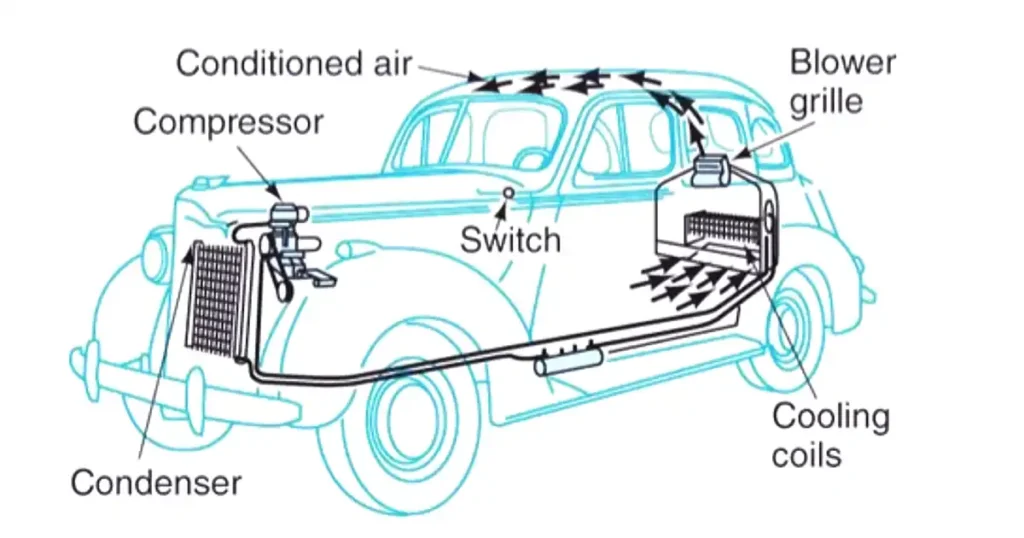Do you love cruising in a chilly, comfortable car on a blazing summer day? Well, you can thank Packard for bringing that luxury to automobiles. In this blog post, we’ll dive into the fascinating story of how Packard became the first U.S. auto manufacturer to offer air conditioning as a factory option back in 1940. Along the way, we’ll explore the challenges and innovations that went into creating this groundbreaking feature.
The Quest for the First Air-Conditioned Car

Before we dig into the nitty-gritty, let’s clear up a common misconception: the 1940 Packard wasn’t the absolute first car with air conditioning. There were some earlier DIY and experimental systems in the 1930s. However, what Packard did differently was offer air conditioning as a regular factory option. This meant that you could order your Packard with air conditioning straight from the factory. It came at a price, though, ranging from $275 to $310, which was quite a hefty sum in those days.
Interestingly, Packard didn’t initially call it “air conditioning.” They referred to it as “mechanical refrigeration” and later as “weather conditioner.” The term “air conditioning” gained popularity later on.
Cracking the Code: How Packard’s Air Conditioning Worked
Packard’s air conditioning system was supplied by the Bishop & Babcock Manufacturing Co. of Cleveland. It resembled a modern A/C unit but with some unique features. Here’s a breakdown of how it operated:
The system had four key components: a compressor, an evaporator coil, an air blower, and a condenser. The compressor, a twin-cylinder vertical unit, was mounted on the cylinder head of the straight 8 engine and driven by a V-belt. This compressor circulated DuPont Freon refrigerant throughout the system.
Behind the rear passenger seat, you’d find the evaporator coil and air blower. The evaporator coil cooled the air by soaking up its heat, while the air blower pushed that refreshing coolness into the cabin through rear shelf vents.
Under the hood, in front of the radiator, sat the condenser, releasing heat from the refrigerant into the outside air.

The Roadblocks and Limits of Packard’s Air Conditioning
Packard’s air conditioning system was indeed an engineering marvel, but it had some quirks that prevented it from being widely adopted by consumers. Here are some of the challenges and limitations that Packard encountered:
- The placement of the evaporator coil and air blower wasn’t ideal. It encroached on trunk space and sometimes led to chilly necks for passengers. Adjusting the temperature and airflow in different parts of the cabin was a bit tricky.
- The compressor lacked an electromagnetic clutch and couldn’t be turned off. It ran continuously when the engine was on. During cold weather, the drive belt had to be manually removed.
- The system had no fresh air intake, resulting in the endless recirculation of cabin air. This could cause unpleasant odors and decrease oxygen levels inside the car.
- The system was noisy and bulky, adding complexity and weight to the vehicle. It also required frequent maintenance and repairs.


Packard’s Air Conditioning Legacy
Despite these challenges, Packard’s air conditioning system was a groundbreaking innovation that paved the way for future improvements. Some 1940-42 Packards were equipped with this system, and a few still exist today. The Bishop & Babcock unit also found its way into some 1941 Cadillacs and Chrysler Imperials, as an extra-cost option on the 1942 DeSoto.
Packard’s air conditioning system was one of the last examples of automotive A/C units behind the rear passenger seat. In 1954, Nash and General Motors introduced dash-integrated systems similar to what we have in cars today. These systems delivered better performance, convenience, and aesthetics.
After World War II, air conditioning became more popular and affordable in American cars. By 1970, nearly half of all new American cars came with air conditioning. Today, it’s a standard feature in almost every car.
Packard’s air conditioning system was a milestone in automotive history. It proved that creating a cool and comfortable car environment was possible, showcasing Packard’s engineering prowess and innovation. It was a cool idea that forever changed the world of automobiles.
